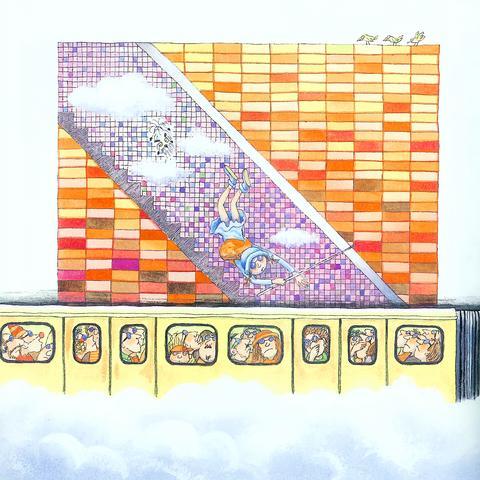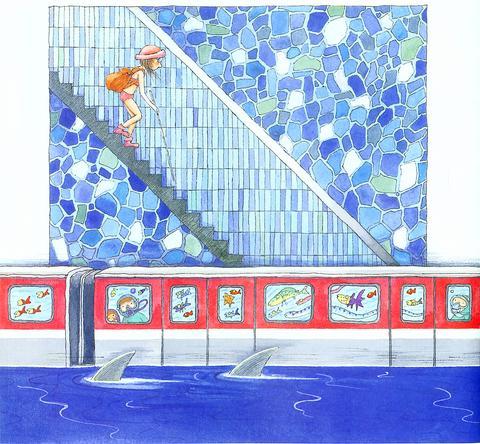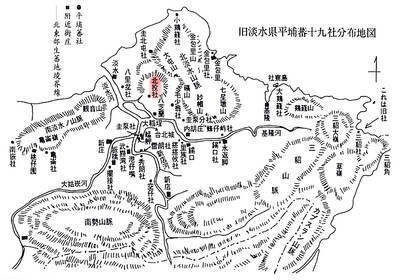A combination of best-selling illustrated book author Jimmy Liao (幾米), theater director Miguel Li (黎煥雄) and film star Wing Fan (范植偉) has ensured the success of Sound of Colors -- Jimmy's Subway Book, a Musical Journey (地下鐵), the latest play from Taipei's Creative Society
(創
Jimmy Liao's first stage presentation of one of his books -- which are popular in Taiwan, Hong Kong and China -- has created such a buzz that tickets for the six performances at the National Theater in Taipei, started yesterday, sold out two weeks ago.

PHOTO COURTESY OF LOCUS PUBLISHING
"I have been anticipating this for so long, like the audience, and want to see the result. I want to see the crew really bring out that flower in my heart," said Liao, in language that is characteristic of his books.
In the large ballet rehearsal room at the National Theater, the crew for Sound of Colors repeatedly rehearsed each scene. Chen Chien-chi (陳建騏), the composer, directed the musicians through the jolly and slightly sentimental songs, creating an ambience for the setting, which is imaginary subway stations.
Pop singer Chen Chi-chen (陳綺貞) plays the protagonist, a young blind girl who takes a bold adventure, going alone, into the unknown world of subway stations. Chen, putting on her props -- shades and a walking stick -- moved toward the center of the rehearsal room. Wing Fan, who plays the mysterious man in black, stayed in a corner, reciting his lines. Then, a group of singers and dancers, in their colorful costumes showed up at the front of the stage, while director Li called on his actors to position themselves. "Wing, now you take position!"

PHOTO COURTESY OF LOCUS PUBLISHING
Published three years ago, Sound of Colors is one of Jimmy Liao's most popular books. It is the second time one of Liao's stories has been adapted to a different media. A Chance of Sunshine (向左轉, 向右轉) was adapted into the movie Turn Left, Turn Right by Hong Kong director Jonny To (杜琪峰). The Warner Brothers group invested in the movie, which is scheduled to be released in
September.
The story of Sound of Colors describes a young lady who lost her eyesight in early childhood and decides to take a subway trip to her 15th birthday party, by walking aimlessly through different stations. In Liao's delicate, colorful and imaginary landscape, the girl's adventure turns out to be a journey that tests her courage and attitude toward life.

PHOTO COURTESY OF LOCUS PUBLISHING
"What can be seen, and what cannot be seen, and what is the departure and what is the destination all become unclear as the play unfolds," Liao said.
"The inspiration I had for the book was based on many of my memories of traveling. I've been to different subway stations and seen different scenes, all shifting and fleeting," Liao said.
"In the story, the blind girl could not see the world's scenery, but imagination has made her world broader and her life more free."
Liao said when he created Sound of Colors, he tried to present the life journey like a play, which happened in acts. So, he said, he was happy to see the book actually become a play. The director is Liao's good friend, director Miguel Li. As a music producer he has produced four albums based on the illustrated works of Liao. He said Jimmy's unique sensitivity and his clear and simple language, allied to the solid and original pictures, created a glamorous image. "This is the main reason why he [Liao] wanted to adapt the book into a play."
To give Jimmy Liao's prose style a clearer dramatic narrative, Li has created more roles for the play, including the mysterious angel in black played by Wing Fan, the girl's father, a gardener and a railway worker. There will also be penguins, elephants, butterflies, Death and a toy soldier with minor parts.
"Basically, the play is something between the fairytale Alice in Wonderland and the black existentialism of novelist Franz Kafka," Li said. "I will not start from the perspective of the blind girl, instead, I will come from the angle of the father, who views life in terms of uncertainty."
In terms of style, Li has made Sound of Colors into a hybrid of musical and play, which has given give pop singers Chen Chi-chen and Huang Shin-shin (黃心心) roles to play. As for Wing Fan, the up-and-coming star who gained fame in the film Best of Times (美麗時光) and Crystal Boys (孽子),this will be his maiden singing performance.
"I'm a bit nervous, but the whole process is a lot of fun," he said.
Wing Fan, who last year joined Wong Kar-wai's (王家衛) Jet Tone Production Co (澤東電影公司) and will feature in Wong's future films. His good looks and brooding personality is said to be the main reason Wong signed him up for Jet Tone. But in the play, director Li finds another trait in Wing Fan. "He is not that melancholy. In rehearsal, he is like a naughty kid, jumping around and talking a lot more.
Having overseen the rehearsal, Liao said he was excited about the play, and having Xia Yu (夏宇) -- the famous poet -- write the lyrics for the songs. "I'm just very satisfied," he said.

Seven hundred job applications. One interview. Marco Mascaro arrived in Taiwan last year with a PhD in engineering physics and years of experience at a European research center. He thought his Gold Card would guarantee him a foothold in Taiwan’s job market. “It’s marketed as if Taiwan really needs you,” the 33-year-old Italian says. “The reality is that companies here don’t really need us.” The Employment Gold Card was designed to fix Taiwan’s labor shortage by offering foreign professionals a combined resident visa and open work permit valid for three years. But for many, like Mascaro, the welcome mat ends at the door. A

The Western media once again enthusiastically forwarded Beijing’s talking points on Japanese Prime Minister Sanae Takaichi’s comment two weeks ago that an attack by the People’s Republic of China (PRC) on Taiwan was an existential threat to Japan and would trigger Japanese military intervention in defense of Taiwan. The predictable reach for clickbait meant that a string of teachable moments was lost, “like tears in the rain.” Again. The Economist led the way, assigning the blame to the victim. “Takaichi Sanae was bound to rile China sooner rather than later,” the magazine asserted. It then explained: “Japan’s new prime minister is

Divadlo feels like your warm neighborhood slice of home — even if you’ve only ever spent a few days in Prague, like myself. A projector is screening retro animations by Czech director Karel Zeman, the shelves are lined with books and vinyl, and the owner will sit with you to share stories over a glass of pear brandy. The food is also fantastic, not just a new cultural experience but filled with nostalgia, recipes from home and laden with soul-warming carbs, perfect as the weather turns chilly. A Prague native, Kaio Picha has been in Taipei for 13 years and

NOV. 24 to NOV. 30 It wasn’t famine, disaster or war that drove the people of Soansai to flee their homeland, but a blanket-stealing demon. At least that’s how Poan Yu-pie (潘有秘), a resident of the Indigenous settlement of Kipatauw in what is today Taipei’s Beitou District (北投), told it to Japanese anthropologist Kanori Ino in 1897. Unable to sleep out of fear, the villagers built a raft large enough to fit everyone and set sail. They drifted for days before arriving at what is now Shenao Port (深奧) on Taiwan’s north coast,